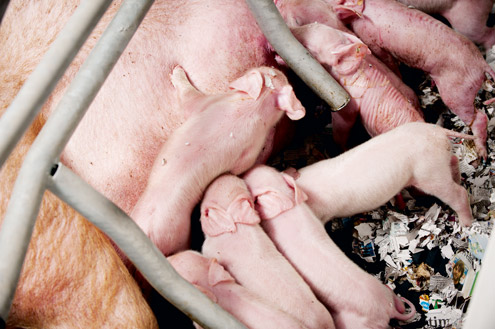Focus on sow condition for uniform piglet litters

Maintaining optimum sow body condition and paying close attention to gilt feeding will help UK pig producers get on target to wean three extra pigs a sow a year.
| Why aim for three extra pigs weaned a sow a year? |
|---|
| • Current UK figures for pigs born and weaned are behind the rest of Europe. • Between 2006 and 2012, Britain improved the number of pigs born a sow a year by 1.07 versus 4.64 in Germany. • Pigs weaned a sow a year average 23.9 on UK indoor units versus 28.8 in Denmark • By producing more pigs there is the potential to reduce sow numbers and save feed, while making the most of pig markets |
Dutch producers are already achieving an average of 28.5 weaned pigs a sow a year.
However, increased litter size has brought additional challenges that should be noted by British farmers aiming to increase litter size.
In Holland they are on target to wean an average of 32.2 piglets a sow a year by 2020. But it does bring challenges, explained René Bonekamp of Dutch company ForFarmers at a BPEX and BOCM Pauls conference focussed on the Breed+3 programme, which is aimed at helping herds wean an extra three pigs a sow a year.
He said a sample of Dutch and German farms showed nearly 20% of piglets were at risk of dying because they weighed less than 1kg at birth. BOCM Pauls figures also showed a correlation between birth weight and pre-weaning mortality, with piglets weighing 0.5kg having a pre-weaning mortality of 83%.
“Every extra live-born piglet reduces the average piglet birth weight by 35g,” said Mr Bonekamp.
The aim should be to produce a uniform litter that will be more likely to survive – thus helping to boost the number of pigs weaned a sow a year.
“The basis of a uniform litter is the sow itself and her body condition,” stressed Mr Bonekamp.
Weight loss during lactation also influences the next litter. Research has shown 20% of pigs with the highest weight loss in lactation of more than 13% had the greatest variation in piglet birth weight.
The proportion of stillbirths was also likely to increase when sows were overweight. For example, in a sample of seventh- and eighth-parity sows, the heaviest 50%, which weighed 332kg, had 14.77% stillborn young. This compared to 9.88% in the lightest 50%, which weighed 304.50kg.
Speaking to Farmers Weekly, Mr Bonekamp said if he had one main message for UK producers it would be to exercise precise feeding and focus on the sow.
“Measure back fat and weight just before farrowing and weaning and at 40 days and 70 days of gestation. You need this information to do precise feeding.”
He also said feeding the gilts correctly during gestation was crucial. “A gilt requires almost 60% more lysine and 6% more energy versus a parity-six pig,” Mr Bonekamp said.
“Often gilts are fed the same high-energy, high-amino acid gestation diet as sows, but this is based on the sow and the fact she needs to gain weight from the previous farrowing.”
He said there was the opportunity at this stage to feed gilts a different balanced diet with higher amino acids to help the development of the gilt and not fat.
“This will set the gilt up so she is more likely to achieve the target of an extra three pigs weaned a year in the future,” he explained.
